Connected Drug Delivery Devices Market Research, 2030
The global connected drug delivery devices market size was $290.3 million in 2021, and is projected to reach $2.1 billion by 2030, growing at a CAGR of 24.3% from 2022 to 2030. Smart wireless electronic systems known as connected drug delivery devices are used to support patient monitoring and counseling in residential settings. They come with sensors, adherence trackers, dose reminders, and monitoring systems that offer real-time feedback and educational resources for individualized patient care. They are convenient and less expensive than treatment received in a clinic. As a result, connected drug delivery devices are frequently utilized in the remote monitoring of patients with conditions such as asthma, diabetes, hepatitis C, hypertension, tuberculosis, multiple sclerosis, clinically isolated syndrome, Chronic Obstructive Pulmonary Disease (COPD), and recipients of liver and kidney transplants.
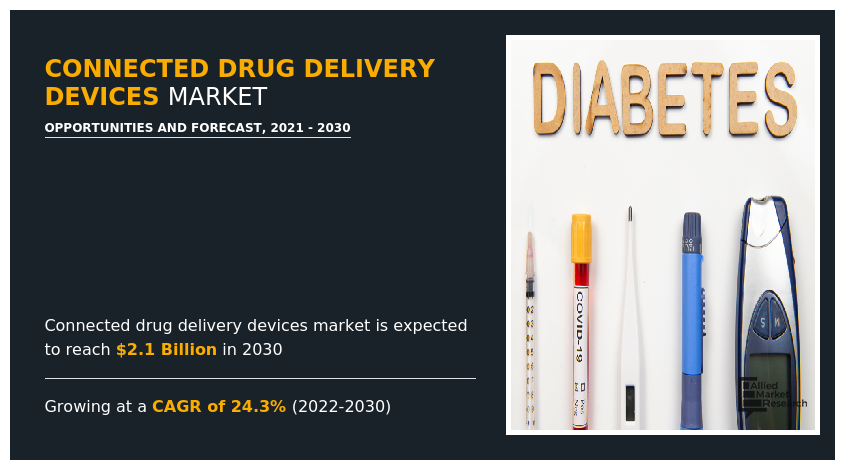
The connected drug delivery devices market is segmented into Type, Technology and End-use.
The rapidly increasing cost of medical management and increasing need to improve patient treatment outcomes are among the main factors causing the demand for connected drug delivery devices. Besides this, a shift in preferences towards home-based care is also stimulating the market growth. Moreover, rising number of individuals suffering from chronic diseases, along with increasing emphasis on preventive care, is influencing the market positively. Furthermore, widespread adoption of connected devices in laboratories and hospitals for maintaining Electronic Health Records (EHR) is expected to drive the market growth.
However some disadvantages are concerns about patient treatments data security could prevent the sector from growing. Information such as medical records, insurance IDs that may contain social security and bank information, medical details, and location could all be severely lost as a result of a breach in data protection. The reputation of the medical devices manufacturer can suffer as a result. Threats to cyber security could seriously endanger hospitals and patients. Such severe and major risks related to medicine delivery device solutions could reduce the market revenue during the anticipated period.
It has been discovered that connected drug delivery devices can assist doctors monitor patient compliance with their recommended therapy and adjust a patient's treatment as needed. The adoption of linked drug delivery devices is anticipated to be accelerated by an increase in attempts to raise awareness regarding complications brought on by under- or overdosing of medications. As a result, the market is projected to rise as knowledge of the negative impacts of non-adherence growth in the connected drug delivery devices market size. Furthermore, increasing awareness regarding the benefits of connected systems over conventional systems is further expected to augment the product demand, thereby driving the market revenue growth over the forecast period.
Some of the major connected drug delivery devices industry players include Adherium, BD, Proteus Digital Health, propeller Health, F. Hoffmann-La Roche Ltd, Ypsomed AG, Cohero Health, Inc., West Pharmaceutical Services, Inc., Syncro Technology Corp., and AptarGroup Inc.
The globalconnected drug delivery devicesmarket is segmented on the basis of type, technology, end-user, and region. By type, the market is sub-segmented into injectable devices, inhalation devices, and others. By technology, the market is classified into NFC, Bluetooth, and others. By end-user, the market is sub-segmented into homecare settings and hospitals.By region, the market is analyzed across North America, Europe, Asia-Pacific, and LAMEA.
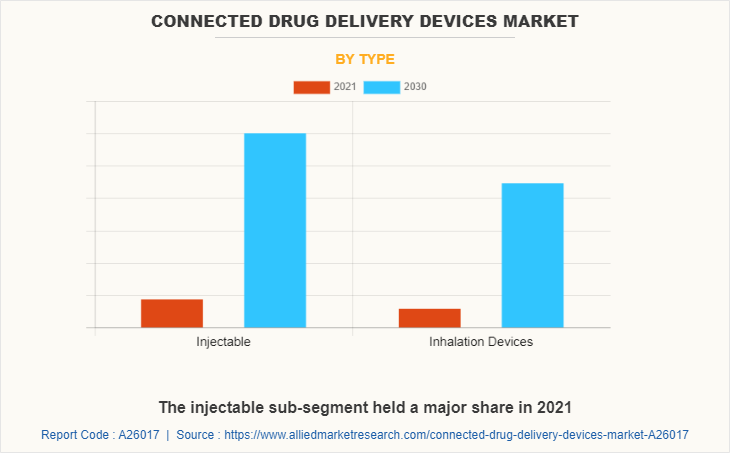
By type, the injectable devices sub-segment to have the highest market share and expected to register a revenue in 2021. The injectable devices sub-segment is estimated to account for the maximum share of the market. Certain factors, such as the numerous benefits offered by smart injectable devices over the traditional injectable devices and an increasing prevalence of chronic conditions, namely, cancer, neural disorders, diabetes, and others are actively contributing to growth of the sub-segment. Moreover, entry of several drug manufacturers to develop smart injectable devices is projected to offer significant growth opportunities for the injectable devices sub-segment during the forecast period.
The inhalation devices and others sub-segments, on the other hand, are expected to drive the market of inhaler device, owing to rising prevalence of asthma, Chronic Obstructive Pulmonary Disorders (COPD), and other respiratory diseases. Also, increasing emphasis on the utilization of digital devices for better treatment outcomes would accelerate growth of the market. Moreover, increasing collaborations between the market players and healthcare institutions is further expected to expand the inhalation devices sub-segment in the global connected drug delivery devices market during the forecast period.
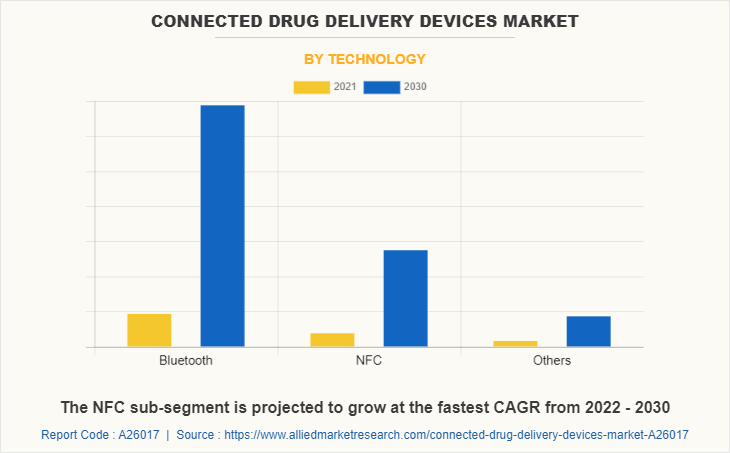
By technology, the Bluetooth sub-segment is estimated to dominate the market owing to higher utilization of the technology in order to connect drug delivery devices to smartphones. Moreover, higher compatibility of Bluetooth technology with other drug delivery devices and ease of use is expected to drive the Bluetooth sub-segment growth over the forecast period.
The NFC sub-segment is anticipated to be the fastest growing in the market during the forecast period. Numerous benefits offered by the NFC devices, such as extended battery life and superior data transmission are projected to increase the adoption of these devices, which will eventually drive revenue growth of the NFC sub-segment.
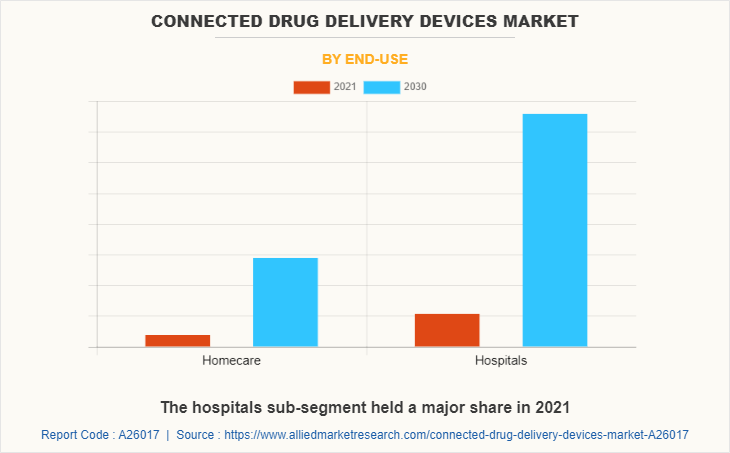
On the basis of end-user, the homecare settings sub-segment is estimated to dominate the market throughout the forecast period. An increasing adoption of the connected drug delivery devices owing to a need to provide better patient experience, coupled with a rise in the prevalence of COPD and asthma are projected to offer substantial amount of growth for this sub-segment in the connected drug delivery devices market.
Besides, the rapidly developing healthcare infrastructure and rising emphasis on the utilization of improved procedural outcomes are anticipated to offer growth opportunities to the hospitalssub-segment and anticipated to be the fastest growing in the connected drug delivery devices market during the forecast period.
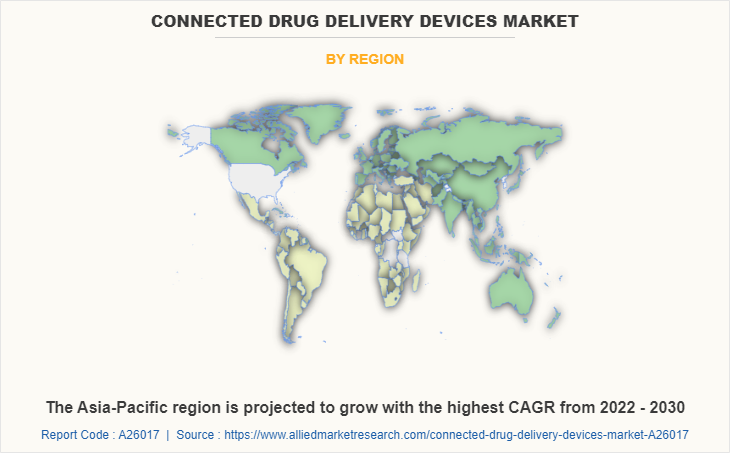
By region, North America generated revenue in 2021 and is projected to dominate the global connected drug delivery devices market throughout the forecast period. Highly developed healthcare infrastructure and healthcare spending, presence of significant market players, and strategic collaborations are the major factors attributable to the dominance of this region in the market. Combined with this, an increasing prevalence of chronic diseases in the U.S. and rising focus on preventive care are anticipated to drive growth of the market in this region during the forecast period.
In Asia-Pacific, increasing awareness regarding connected drug delivery devices, cost benefits, and rapid adoption of medical technology in China, India, and others are generating huge opportunities for growth of the market. Across rest of the world, implementation of intense marketing strategies by market players, increasing healthcare spending, and expected expansion of the distribution network of key players are some of the primary factors augmenting the connected drug delivery devices market share.
Highlights of the Report
- The report provides exclusive and comprehensive analysis of the global connected drug delivery devices market trends along with the connected drug delivery devices market forecast
- The report elucidates the connected drug delivery devices market opportunity along with key drivers, and restraints of the market. It is a compilation of detailed information, inputs from industry participants and industry experts across the value chain, and quantitative and qualitative assessment by industry analysts.
- Porter’s five forces analysis helps analyze the potential of the buyers & suppliers and the competitive scenario of the market for strategy building
- The report entailing the connected drug delivery devices market analysis maps the qualitative sway of various industry factors on market segments as well as geographies
- The data in this report aims on market dynamics, trends, and developments affecting the connected drug delivery devices market growth
COVID-19 Impact onConnected Drug Delivery Devices Industry
- The COVID-19 pandemic has put an incredible strain on the healthcare system and has created a respiratory state of emergency for patients with severe respiratory conditions. Digital health, telemedicine and remote monitoring is making it possible to keep these patients safer in their homes by avoiding unnecessary in-person office and emergency room visits, improving engagement and overall health, and providing more direct communication between patients and their providers.
- Remote monitoring and telehealth are quickly becoming a new, additive standard of care. Continuous expansion of telehealth and remote monitoring services, especially for products in the respiratory diseases category, is essential for reducing health care costs while improving patient management.
- In October 2021, Roche made a joint development agreement with Ibex Medical Analytics, a global leader in Artificial Intelligence (AI)-based cancer diagnostics. Under the agreement, they will jointly develop an embedded image analysis workflow for pathologists to seamlessly access to exchange data securely, Ibex’s AI algorithms, insights and decision support tools using Navify Digital Pathology, which is the cloud version of uPath enterprise software.
Connected Drug Delivery Devices Market Report Highlights
| Aspects | Details |
| Market Size By 2030 | USD 2.1 billion |
| Growth Rate | CAGR of 24.3% |
| Forecast period | 2021 - 2030 |
| Report Pages | 210 |
| By Type |
|
| By Technology |
|
| By End-use |
|
| By Region |
|
| Key Market Players | BD, Syncro Technology Corp., Proteus Digital Health, F. Hoffmann-La Roche Ltd, Adherium, Ypsomed AG, PROPELLER HEALTH, Cohero Health, Inc., West Pharmaceutical Services, Inc., AptarGroup Inc. |
Analyst Review
Increasing adoption of electronic technology in healthcare devices along with the efficiency of drug delivery devices in treatment procedures are projected to drive the connected drug delivery devices market growth during the forecast period. In addition, rising number of individuals suffering from chronic diseases, along with increasing emphasis on preventive care, is influencing the market positively. However, security concerns regarding patient data may hamper the market expansion. The breach in data security may lead to huge losses of confidential information such as medical records, insurance IDs which may contain social security and bank details, medical details, and location. On the contrary, rising product innovations and development owing to technological advancements all around the world will extend profitable opportunities for the market players in the forecast period.
Among the analyzed regions, North America is expected to account for the highest revenue in the market by the end of 2031, followed by Asia-Pacific, Europe, and LAMEA. Rapid increase in R&D and technological advancements are the key factors responsible for leading position of Europe and Asia-Pacific in the global connected drug delivery devices market.
Shift in preferences towards home-based care, adoption of connected devices in laboratories and hospitals, easy for physicians to monitor the home based patient and modify the treatment as per requirement which is expected to be the major market driver. In addition, immense focus on technological advancements is further aiding the market to grow at a significant rate
The major growth strategies adopted by connected drug delivery devices market players include collaboration and mergers & acquisitions
Asia-Pacific will provide more business opportunities for the global connected drug delivery devices market in future.
Some of the leading connected drug delivery devices market players include Adherium, BD, Proteus Digital Health, propeller Health, F. Hoffmann-La Roche Ltd, Ypsomed AG, Cohero Health, Inc., West Pharmaceutical Services, Syncro Technology Corp., and AptarGroup Inc.
The homecare setting sub-segment of the end-user acquired the maximum share of the global connected drug delivery devices market in 2021.
Patients with chronic diseases and hospitals are the major customers in the global connected drug delivery devices market.
The report provides an extensive qualitative and quantitative analysis of the current trends and future estimations of the global connected drug delivery devices market from 2022 to 2030 to determine the prevailing opportunities.
The use of connected drug delivery devices as error free drug delivery system, as a patient monitoring system and self-administration drug delivery system are the applications that are estimated to drive the adoption of connected drug delivery devices.
Increasing application of connected drug delivery devices and continuing advancements in device and sensor technology, telemetry, cyber security, and data processing in healthcare procedural paradigms facilities are anticipated to boost the connected drug delivery devices market in the upcoming years.
Loading Table Of Content...


